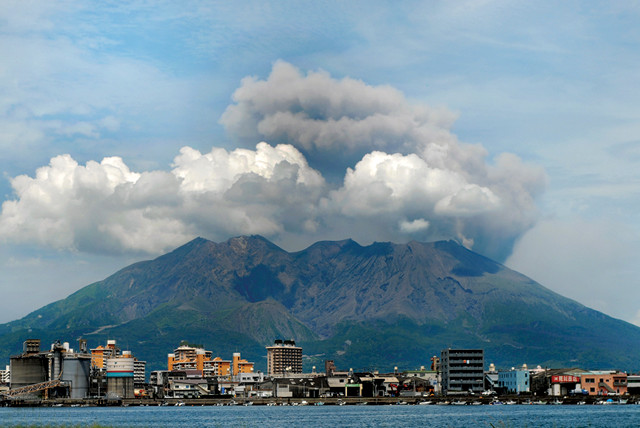
by Adityarup "Rup" Chakravorty Tuesday, December 27, 2016

Magma accumulating beneath Sakurajima Volcano indicates that an eruption — one on par with a major event in 1914 that covered nearby Kagoshima (foreground) in ash — could occur within a few decades. Credit: Mstyslav Chernov, CC BY-SA 3.0.
In January 1914, Japan’s most active volcano, Sakurajima, erupted violently, covering the nearby city of Kagoshima in a layer of ash. The lava flows from this event filled the strait between the mainland and the island volcano, transforming it into a peninsula.
Sakurajima is located in a giant caldera — the Aira Caldera — that formed more than 20,000 years ago during another violent eruption. According to a new study in Scientific Reports, magma is accumulating beneath the caldera at a rate faster than it has been erupted, causing uplift of the caldera floor and leading to conditions similar to those thought to have preceded the 1914 explosion.
Although researchers have previously modeled magma accumulation beneath the caldera, “the majority of the older models took the simple view that all the rocks in the Earth’s crust are cold and homogeneous — i.e., that there are no variations in rock properties with location,” says James Hickey, a volcanologist at the University of Exeter in England and lead author of the study. “In reality, Earth’s crust has different thermal and mechanical properties [depending on where you look].”
Incorporating these differences into models is important to achieve “robust and consistent results,” Hickey says, because “the way Earth responds to magmatic processes — how the crust deforms, for example — is dependent on these thermal and mechanical properties.”
In the new study, Hickey and his colleagues compared six different models that accounted for variabilities in rock properties, as well as other landscape features such as topography, to models that didn’t. They found that the model that most accurately fit the available geophysical data, such as the uplift of the caldera, was one that took into account the heterogeneity of crustal rocks.
According to this best-fit model, magma is accumulating in an oblate-shaped chamber centered about 13 kilometers below the caldera. Based on the rate of magma accumulation in that chamber, the researchers forecast that an eruption similar in scale to the 1914 blowout could occur within a 130-year time frame of that event.
“We are able to present a more complete picture of the volcano evolution and behavior, which is essential for eruption forecasting and hazard assessment,” Hickey says.
Forecasting Sakurajima’s activity is vital for the people who would be most affected by a major eruption — for example, the more than half-million inhabitants of the city of Kagoshima who live within a few kilometers of Sakurajima.
“It’s also important from a scientific perspective because we want to know how monitoring data can relate to eruptive activity, and this volcano offers a great opportunity [to study that relationship] because of its regular activity,” Hickey says.
“It’s great to see more complex approaches [for studying volcanoes] being applied,” says Michael Poland, a geophysicist at the U.S. Geological Survey’s Cascades Volcano Observatory in Vancouver, Wash., who was not involved with the study. This work “offers more information than previous results, and represents a step forward in our understanding of Aira, and also the activity of calderas in general,” he says.
But “the 130-year time frame is tenuous, given that the data the model spans is less than 10 percent of that time frame,” Poland adds. On the other hand, he says, “there is evidence for long-term inflation of the caldera, so extrapolating the recent unrest back to 1914 is not unreasonable, especially if the source of magma accumulation was the same, which seems likely.”
Hickey says he plans to continue developing the technique used in the study to take advantage of the massive amounts of data becoming available from satellites and remote sensing, and to apply it to study other volcanic systems.
*This story has been updated to correct James Hickey’s affiliation. He is no longer at the University of Bristol, as was previously stated. He is currently at the University of Exeter.
© 2008-2021. All rights reserved. Any copying, redistribution or retransmission of any of the contents of this service without the expressed written permission of the American Geosciences Institute is expressly prohibited. Click here for all copyright requests.